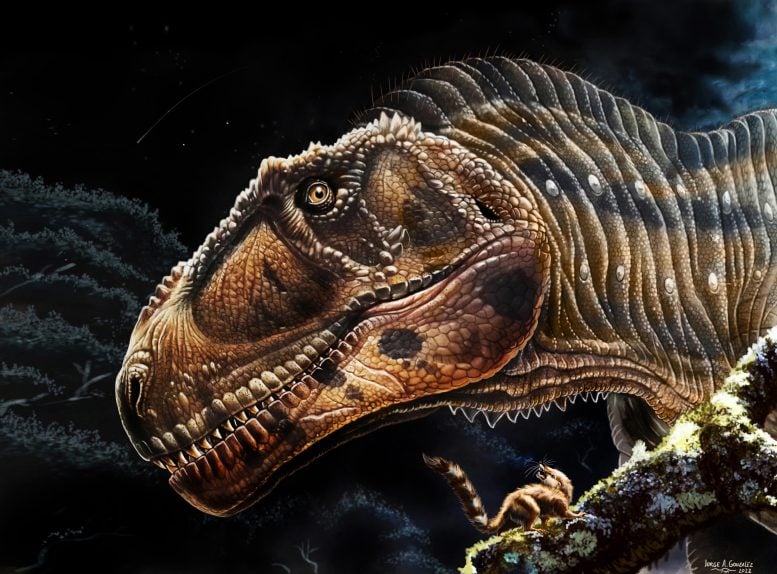
An international team that includes a University of Minnesota Twin Cities researcher has discovered a new big, meat-eating dinosaur, dubbed Meraxes gigas (illustrated above), that provides clues about the evolution and anatomy of predatory dinosaurs such as the Carcharodontosaurus and Tyrannosaurus rex. Credit: Jorge A Gonzalez
Discovery provides insight into the evolution and anatomy of big, carnivorous dinosaurs.
Researchers discovered a new huge, meat-eating dinosaur, dubbed Meraxes gigas. The new dinosaur provides fascinating clues about the evolution and biology of dinosaurs such as the Carcharodontosaurus and Tyrannosaurus rex—particularly, why these creatures had such large skulls and tiny arms.
The study was co-led by University of Minnesota Twin Cities researcher Peter Makovicky and Argentinean colleagues Juan Canale and Sebastian Apesteguía and was published in Current Biology, a peer-reviewed scientific biology journal.
Initially discovered in Patagonia in 2012, scientists have spent the last several years extracting, preparing, and analyzing the Meraxes specimen. The dinosaur is part of the Carcharodontosauridae family. This group of giant carnivorous theropods also includes Giganotosaurus, one of the largest known meat-eating dinosaurs and one of the reptilian stars of the recently released “Jurassic World: Dominion” movie.
Though not the largest among carcharodontosaurids, Meraxes was still an imposing animal measuring around 36 feet (11 meters) from snout to tail tip and weighing approximately 9,000 pounds (4,000 kg). The researchers recovered the Meraxes, alongside other dinosaurs including several long-necked sauropod specimens, from rocks that are around 90-95 million years old.
Meraxes is among the most complete carcharodontosaurid skeletons paleontologists have found thus far in the southern hemisphere. It includes nearly the entirety of the animal’s skull, hips, and both left and right arms and legs.
“The neat thing is that we found the body plan is surprisingly similar to tyrannosaurs like T. rex,” said Peter Makovicky, one of the principal authors of the study and a professor in the University of Minnesota N.H. Winchell School of Earth and Environmental Sciences. “But, they’re not particularly closely related to T. rex. They’re from very different branches of the meat-eating dinosaur family tree. So, having this new discovery allowed us to probe the question of, ‘Why do these meat-eating dinosaurs get so big and have these dinky little arms?’”
“The discovery of this new carcharodontosaurid, the most complete up to now, gives us an outstanding opportunity to learn about their systematics, paleobiology, and true size like never before,” said Sebastian Apesteguía, a co-author of the study and a researcher at Maimónides University in Argentina.
With the statistical data that Meraxes provided, the researchers found that large, mega-predatory dinosaurs in all three families of therapods grew in similar ways. As they evolved, their skulls grew larger and their arms progressively shortened.
The possible uses of the tiny forelimbs in T. rex and other large carnivorous dinosaurs have been the topic of much speculation and debate.
“What we’re suggesting is that there’s a different take on this,” Makovicky said. “We shouldn’t worry so much about what the arms are being used for, because the arms are actually being reduced as a consequence of the skulls becoming massive. Whatever the arms may or may not have been used for, they’re taking on a secondary function since the skull is being optimized to handle larger prey.”
The researchers also found that carcharodontosaurids including species from Patagonia evolved very quickly, but then disappeared suddenly from the fossil record very soon after.
“Usually when animals are on the verge of extinction, it’s because their evolutionary rates are quite slow, meaning they aren’t adapting very quickly to their environment,” explained Juan Canale, the study’s lead author and a researcher at the National University of Río Negro. “Here, we have evidence that Meraxes and its relatives were evolving quite fast, and yet within a few million years of being around, they disappeared, and we don’t know why. It’s one of these finds where you answer some questions, but it generates more questions for the future.”
For more on this research, see Giant New Carnivorous Dinosaur Discovered With Tiny Arms Like T. rex.
Reference: “New giant carnivorous dinosaur reveals convergent evolutionary trends in theropod arm reduction” by Juan I. Canale, Sebastián Apesteguía, Pablo A. Gallina, Jonathan Mitchell, Nathan D. Smith, Thomas M. Cullen, Akiko Shinya, Alejandro Haluza, Federico A. Gianechini, Peter J. Makovicky, 7 July 2022, Current Biology.
DOI: 10.1016/j.cub.2022.05.057
The research was funded by the National Geographic Society, Municipalidad de Villa El Chocón, Fundación “Félix de Azara,” and the Field Museum in Chicago.
In addition to Makovicky, Apesteguía, and Canale, the research team included National University of Río Negro researcher Alejandro Haluza; Maimónides University researcher Pablo Gallina; West Virginia Institute of Technology Assistant Professor Jonathan Mitchell; Natural History Museum of Los Angeles County researcher Nathan Smith; Carleton University researchers Thomas Cullen; Akiko Shinya of the Field Museum in Chicago; and National University of San Luis researcher Federico Gianechini.

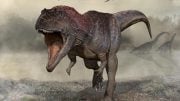
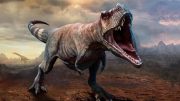
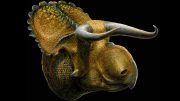
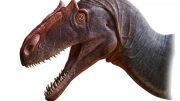
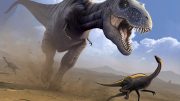
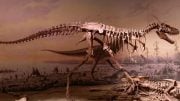
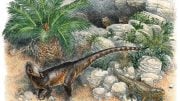
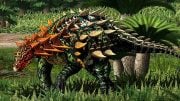
More prove carcharodontosauridae is a tyrannosaur meraxes hip fuse like the mesoeucrocodylia notosuchus very rare in animal like birds they call that synsacrum because it’s so rare maybe human too it’s different fusion than sacral it’s the fuse centra vertebrae .notosuchus has 3 sacral vertebrae this is rare in gator type mesoeucrocodylia lots of sacral vertebrae is a bipedal feature but herrerasaurus and gator has 2 and they are bipedal lost of sacral is a feature in reptile in 3 toe claws modern crocodilian a fossil giant caiman has 3 in gator type mesoeucrocodylia mostly 2 .this is more prove dinosaur are alive the tyrannosaur dinosaur is the greatest dinosaur and they are the reason for disappeared rest of dinosaur and 4 toe claw mesoeucrocodylia.spinosauridae tyrannosaur is the superior tyrannosaur .mesoeucrocodylia live.gator performance is prove that it is a dinosaur superior to other reptile it has tapetum lucidum it’s cat eyes glow it’s a great night hunter you can not hide that cat is a cat .notosuchus vertebrae fusion is number 2 sacral and number 3 sacral.
Article title is misleading. In fact, the article contradicts what the title is implying. As a science-centric publication, this is unacceptable. Please correct it.
Coelophysis, I’ve never seen a bipedal crocodile, but once they start walking around on two legs, that marks the beginning of the end for humans. By staying basically the same for millions of years, they’ve been saving up all of their evolutionary attribute points, waiting for the right moment to splurge and overtake the monkeys who were given the keys to the kingdom without ever having to really work for anything. Once the crocodiles start walking on two legs, there will be an evolutionary explosion. I expect us to be extinct and the crocodiles masters of intergalactic travel within 10 years of them walking on 2 legs.
Agreed
Why do kangaroos have small front arms? It’s the same dynamics, body type.
Seriously, the whole basis of the article remains unanswered. A bunch of random speculation with a click bait title. Time wasters!
What does it take for these scientist to realize the reason these dinosaurs had short arms was the same as kangaroos. It was their method of attack by bounding upon their most often very tall prey. Vegetation had not evolved the limbs as much as they are now. So bounding through the brush ambushing their prey only makes sense. There reason we don’t find evidence of this activity is the movements would be very hard to find since the distance between bounding jumps would make it very hard to find. All the anatomy points to them being bounding ambush hunters. Small arms would make travelling very quickly by bounding like kangaroos only makes sense.
Poor babies. Only able to last a few million years. Such a short lifespan.
The article does nothing to really answer the question, why the weak forelimbs? Carrying the forelimbs for millions of years in hopeful expectation of losing them is not much of an answer. A better answer is that these creatures would be in quite a conundrum if they fell. The limbs could very well be there simply to help them get back up. Ever see a turtle on his back? He’s quite helpless. Think about it. Tie your hands behind your back and then lay down. Then try to get back up on two feet without arms or hands.
Because T Rex rides a scooter and Australopithecus rides a skate board.
Why can’t evolution occur over a matter of weeks or years instead of millions of years? Maybe these creatures had a genetic “defect” which allowed parts of their bodies to grow at different ages and at different rates the longer they stayed alive? Such as gigantism or tadpoles growing into something completely different or the dramatic changes to a mature salmon before it spawns.
Dinosaurs were aquatic. Tiny arms are fins.
Fuse vertebrae is on youtube channel raptor chatter .small arm big leg you find in all modern crocodilian it’s a bipedal feature because they are bipedal. not all animal with this feature are bipedal mountain lion.not all mesoeucrocodylia had arm smaller than the leg there is fossil won with arm bigger than the leg like the Jurassic park sauropod and giraffe a clear dinosaur link .protosuchus type of dinosaur the lack of Cingulum teeth not a tetanuran dinosaur there arms are small leg are big because they are bipedal these primitive dinosaur have many sacral vertebrae 3’4’5’ they allso have human ankle like that tetanuran dinosaur the gator.clearly theropod dinosaur use arm quadrupedal they have well develope pectoral girdle things like furcula to prevent arms to be broken this should end claim theropod was slow this is to prevent the violent forces they face so the arm will not break they were fast .theropod arm are design for grasping not running only could take one step most of the work is done by the leg .theropod arm had bad movement it’s design for land it can not climb trees or swim very well the Tetanuran tail is not crocodilian at all it only could move up and down a specialize bipedal feature .early thecodont and early dinosaur had crocodilian tail ceratosaurus is famous having crocodilian tail allso read about duckbill dinosaur haveing the gator tail .one of dwarf caiman today have tetanuran tail it’s not a good swimmer. The leg of theropod the ankle are fuse so they can not sprawl like a gator they could not crouch like the advance dinosaur the gator so they are dead because of the better dinosaur the gator.the gator can sprawl and be bipedal that why they are so successful.theropod ankle are fuse to tibia and fibia the tetanuran dinosaur .only one is fuse in 4 finger dinosaur another anti sprawl feature they allso have fully open hip socket they are not like the lack of flight skull bird like archaeopteryx and velociraptor bird .theropod femur had a peg .gator hip is open its lies claiming they are not it’s not open like theropod or fossil gator type mesoeucrocodylia.I can not tell the different from theropod and some fossil gator type mesoeucrocodylia hip socket .allso protosuchus type of dinosaur there hip socket is allso open and not all dinosaur had open socket one bird hip dinosaur the hip socket is fully close .archaeopteryx can sprawl flight started out as a sprawl animal that why they have wings on there leg they were not good bipedal like theropod dinosaur.the small arms theropod mite be because they are pack hunting like today crocodilian they were stalking and crouching then launch bipedal for the killer move. fast mammal do not have well develope pectoral girdle like dinosaur and gator but interesting prefurcula of mammal is gone and most advance dinosaur ever the gator they only have one bone not 2 like more primitive animal the 2 bone in bird is fuse turn into furcula dinosaur is like that.so the new speed is to get rid any furcula bone so speedy gator is not good as mammal when it come to furcula bone in another million years it will be gone from the gator the champion dinosaur.some protosuchus type of dinosaur lack a fourth trochanter so they are not bipedal the dinosaur pterosaur allso lack a fourth trochanter
The answer to the question is that the skulls were so large to have larger arms would have been a weight imbalance. Also I have a theory that the dinosaurs would bore their whole head inside of the large dinosaurs they preyed on and the arms if they were larger would have gotten the way. That’s my hypothesis.
That’s what I read it to say. The article doesn’t go so far as to say it is specifically for weight distribution. It certainly does fit the articles general point that the head became the evolutionary priority and the arms just no longer mattered. It left me to wonder what specifically the relationship between the head and arms would have been. Weight distribution is a specific kind of thing that fits. I like it.
As an nonscientist, my guess for why a predator would “suddenly” disappear is a sudden change in prey available. Was there a simultaneous evolution toward smaller, faster prey? Would this make food sources out of reach? No pun intended 😜.
When I learn about crocodilian well develope pectoral girdle I heard about scapulocoracoid fusion like today primitive birds ratites and maniraptoran bird velociraptor and archaeopteryx.in thecodont it’s rare in a dinosauriformies and pterosaur a sting ray mimic aquatic dinosaur and tyrannosaur deinocheirus .deinocheirus is likely is a carcharodontosauridae tyrannosaur like meraxes gigas it did not have grasping hand all finger almost Same size. Deinocheirus and meraxes are the same carcharodontosauridae .I am late the theory about gator lost of prefurcula is true somewon allready did a story on it the journal of experiment biology .it increase gator stride for speed .the link alligator sternal shoulder girdle mobility .deinocheirus have nothing to do with birds it’s not a ornithomimus.it has normal primitive leg like t.rex were the femur bigger than tibia and normal fourth trochanter it’s inner ears is dinosaur it has muscle levator scapulae and it’s a tyrannosaur with mesoeucrocodylia links.
If the legs continue to exist at a greatly reduced size over a long time…amongst various similar dinosaur species. then they must have a purpose.. convergent means a purpose/reason…right?
Truck Driver PhD thesis..continues to be…
Their for hatching.. spreading the leathery shell wider to increase tension to allow the milk-tooth to work it’s magic.
Check how bird wings wrap up inside the shell.beside the head and neck.. pointing up.
Check how lizards hatch…
Truck Driver PhD
Article doesn’t even come close to answering to it’s title’s claim. This was a painful waste of time to reach a paragraph that answers the question by saying “Forget about the question, **** you.”
No one has said the little arms could be for mating. I know how they ate and what they ate . How did they mate ?
Why such small arms? So the couldn’t smoke cigars….at least that’s what they taught us at Cornell…..Geeeze!
Big head, no cattle.
Short arms = No masterbation. This facilitates the evolutionary mandate to mate. Also, making for a very stressed out and lethal apex predator.
That’s a much better explanation than this article.
What about T.Rex and Co.were not loosing their arms, evolutionarily speaking…
Instead through the millennia they were growing their arms for obvious
technical reasons…for example, catch smaller and faster preys…
What about it?
Raww…
Really misleading article. I was all excited to finally learn why T-rex had such small arms!! Unfortunately all I learned was that I shouldn’t be concerned about why they had small arms. That is lame. I expect more SciTechdaily.
Sharks and snakes are examples of voracious predatory eaters that seem to get along just fine without arms at all.
“Sudden disappearance” like so many other large dinosaur types & varying extinct animals. Perhaps, they suddenly got wiped out in a cataclysmic global flood & subsequent climate disruption!
Misleading headline and the article did not provide an answer.
Scitechdaily comes across as less then honest.
Read elsewhere that the small arms were a consequence of not really needing them anymore. Like snakes they did just fine without them after they evolved upright
This article never answers the claim. If the dinosaurs weren’t extinct this article certainly would be
Clickbait
All of the scientists studying these small armed “dinosaurs” are idiots. Look at a turkey skeleton and it becomes incredibly clear that they aren’t arms at all, but infact the remnants of wings. T-Rex and co. Were clearly dragons.
Its natutes way to ensure the species multiplies. It can’t pleasure itself.
Maybe it was because these types of dinosaurs didn’t follow the norm that we follow on land. Carnivores ate carnivores like fish do. They weren’t picky, and maybe it was like loins with big mane, animals with larger tusks or horns, or crabs with the big claws. If the one with the biggest jaw was the one mating, that one would continue passing down it’s genes. If that one also was fighting other predators, it’s small arms were less likely to get injured, leaving it less likely to develop infection and more likely to survive. Animals make all kinds of colorful and large things for mating, not always for survival in the wild or to have a better chance at catching prey. So maybe this big head was more for mating and versing other carnivores than for hunting. Maybe we were all looking in the wrong direction the whole time.
Please explain why the arms of these dinosaurs are small, thanks.
Never even answered the question at the title
All these articles are the same. Dancing around the topic that was never actually discussed. It’s like the title was given after the article was written and whoever gave the title didn’t even read the actual article.
Sooooo… Just confirming that changes happened… nobody understands the PURPOSE of the short arms still… Thanks…
The title indicates there is a reason for the tiny arms. Then the writer says the reason for tiny arms is not important!! Because the head got enormous! What a BS article!
After reading the whole article: you didn’t answer your initial question. The title is misleading. Shame.
I was excited to see why they had small arms… like the title said. Instead, got bait and switched. “They got big heads tho”. Stupid clickbait.